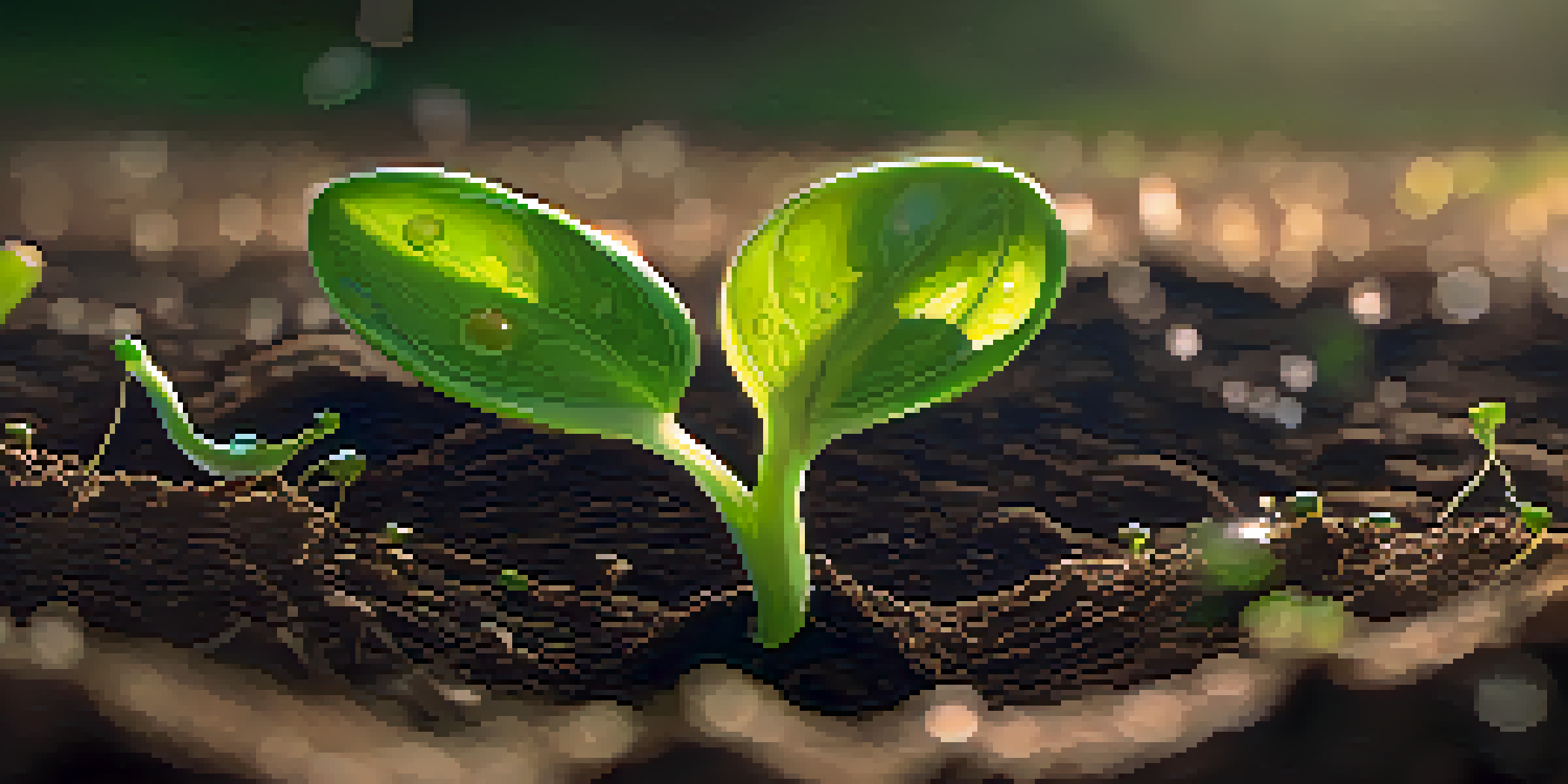Tree Growth Stages: From Seedling to Mature Forests

Understanding the Tree Lifecycle: An Overview
Trees, like all living things, go through a lifecycle that consists of several distinct stages. Understanding this lifecycle is essential for appreciating the role trees play in our environment. From the moment a seed is planted to its transformation into a towering tree, each stage is vital for its growth and survival.
The best time to plant a tree was 20 years ago. The second best time is now.
The tree lifecycle typically includes germination, seedling, juvenile, and mature stages. Each phase presents unique challenges and opportunities, which shape the tree's development. By exploring these stages, we can better understand how trees interact with their ecosystem and support biodiversity.
Moreover, recognizing these stages helps us in conservation efforts, as different stages may require different types of care and protection. This knowledge empowers us to nurture young trees and ensure their long-term health, ultimately benefiting our planet.
Stage One: Germination – The Start of Life
Germination is the magical moment when a seed awakens from dormancy and begins its journey to become a tree. This process usually occurs when conditions are just right—adequate moisture, warmth, and light. The seed absorbs water, swells, and eventually splits open, allowing the first roots to emerge.

During germination, the energy stored within the seed fuels the initial growth, as the tiny seedling pushes its way through the soil. This phase is critical, as young seedlings are vulnerable to environmental stressors, like drought or extreme temperatures. Their survival during this stage sets the foundation for future growth.
Tree Lifecycle Stages Matter
Understanding the distinct stages of a tree's lifecycle—from germination to maturity—helps us appreciate their role in ecosystems and informs conservation efforts.
Understanding germination also highlights the importance of soil health and proper planting techniques. By providing the right conditions for seeds, we can support the next generation of trees and foster a thriving ecosystem.
Stage Two: Seedling – Growth and Resilience
Once germination is complete, the seedling stage begins, characterized by rapid growth as the young tree develops its first leaves. These leaves are essential for photosynthesis, the process by which the tree converts sunlight into energy. During this time, the seedling establishes its root system, which is crucial for stability and nutrient absorption.
In every walk with nature one receives far more than he seeks.
Seedlings are particularly sensitive to their surroundings, needing protection from harsh weather and pests. They often rely on the support of their parent trees or surrounding vegetation for shade and shelter. This dependency emphasizes the interconnectedness of forest ecosystems.
As seedlings grow, they begin to compete for resources such as light and water. This competition fosters resilience, as only the strongest seedlings will thrive, setting the stage for a diverse forest in the future.
Stage Three: Juvenile – Establishing Identity
The juvenile stage marks a significant transition as young trees develop their unique characteristics and begin to branch out. During this phase, trees focus on building height and expanding their canopy. This is when we start to see the distinct shapes and forms that differentiate tree species.
Juvenile trees are also more resilient than seedlings, having developed stronger roots and better defense mechanisms against pests and diseases. However, they still need adequate sunlight and water to thrive, highlighting the importance of a healthy environment for their continued growth.
Human Impact on Forest Health
Our actions, from urban development to sustainable practices, significantly influence the growth and health of forests, emphasizing the need for responsible stewardship.
This stage is a critical time for shaping the future forest structure. As juvenile trees mature, they will eventually compete for space and resources, influencing the overall biodiversity and health of the ecosystem.
Stage Four: Mature Tree – The Heart of the Forest
As trees reach maturity, they become vital components of their ecosystems, providing habitat and resources for countless species. Mature trees are often characterized by their larger size, extensive root systems, and complex branching structures. They play a crucial role in carbon sequestration, helping to mitigate climate change.
In addition to their ecological benefits, mature trees also offer social and economic value. They provide shade, enhance property values, and contribute to the aesthetics of our landscapes. The presence of mature trees can improve air quality and reduce heat in urban areas, making them essential for sustainable living.
However, mature trees face threats such as disease, pollution, and climate change. It is vital to protect these trees to maintain the health of our forests and the myriad of life they support.
Stage Five: Forest Dynamics – The Community of Trees
A mature forest isn't just a collection of trees; it's a dynamic community that thrives on interactions among its inhabitants. Different tree species coexist, each contributing to the ecosystem in unique ways. This diversity fosters resilience, allowing forests to withstand diseases and environmental changes.
Forest dynamics also include processes like competition, succession, and regeneration. As some trees die or are removed, new ones take their place, ensuring the continuity of the forest. This constant evolution is a natural part of a forest's life cycle, maintaining its health and diversity.
Future Challenges for Trees
Despite facing threats like climate change and habitat loss, ongoing conservation efforts and innovative practices offer hope for the future of trees and forests.
Understanding these dynamics is essential for effective forest management and conservation practices. By promoting biodiversity and protecting various tree species, we can ensure the longevity and vitality of our forests.
Stage Six: Human Interaction – Nurturing Our Forests
Humans have a significant impact on the growth and health of forests. From urban development to agricultural practices, our actions can either support or hinder tree growth. Sustainable practices, such as reforestation and responsible land management, are crucial for maintaining healthy ecosystems.
Engaging in tree planting initiatives not only helps restore deforested areas but also fosters a sense of community and stewardship. By getting involved, we can educate ourselves and others about the importance of trees and their role in our environment.

Moreover, understanding our relationship with trees can inspire more sustainable choices in our daily lives. Simple actions, like supporting local forestry programs or reducing paper consumption, can contribute to the health of our forests.
Stage Seven: The Future of Trees and Forests
Looking ahead, the future of trees and forests faces challenges from climate change, habitat loss, and invasive species. However, there is hope in ongoing conservation efforts and advancements in sustainable forestry practices. By prioritizing the health of our forests, we can help ensure their survival for generations to come.
Innovative approaches, such as urban forestry and agroforestry, offer exciting solutions to integrate trees into our landscapes more effectively. These methods not only enhance biodiversity but also provide economic benefits and improve community resilience to climate change.
Ultimately, the journey from seedling to mature forests is a testament to the resilience of nature. By understanding and valuing this process, we can play a vital role in protecting and nurturing our trees, ensuring a greener, healthier planet.